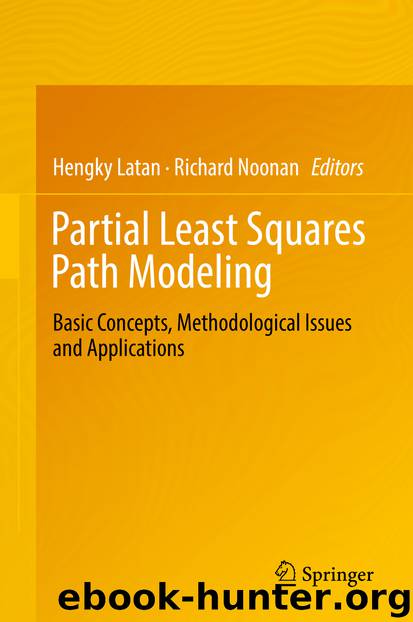Partial Least Squares Path Modeling by Hengky Latan & Richard Noonan

Author:Hengky Latan & Richard Noonan
Language: eng
Format: epub
Publisher: Springer International Publishing, Cham
(8.4)
where M 1 and M 2 are the specific indirect effects and DM is the difference between these two specific indirect effects. In this way, we test whether two specific indirect effects are equal or if they amount to zero. In the case examined in this study, the equation for Fig. 8.2 would be D M = (a 1 × b 1) − (a 2 × b 2). Again, researchers can calculate the equation using a spreadsheet application to build a confidence interval with the help of the bootstrapping results of the PLS program (cf. Chin et al. 2013; Rodríguez-Entrena et al. 2016).
A frequently encountered case is that in which two mediators are connected to each other. This indicates an additional relationship between M 1 and M 2 in Fig. 8.2. Next, we provide examples of how to test such multiple mediation relationships in a PLS path model. In such a case, the total effect c can be calculated as follows: c = c ′ + (a 1 × b 1) + (a 2 × b 2) + (a 1 × a 3 × b 2), where a 3 stands for the relation between M 1 and M 2. An interesting case in this situation is when a 2, b 2, and c′ are not significantly different from zero, but the indirect effect (a 1 × a 3 × b 2) is (e.g., when M 1 is the causal predecessor of M 2); this would mean that M 1 fully mediates the direct effect between X and M 2 and that M 2 fully mediates the direct effect between M 1 and Y, thus establishing a direct causal chain X → M 1 → M 2 → Y (Mathieu et al. 2008). Next, we illustrate this in our second example.
Download
This site does not store any files on its server. We only index and link to content provided by other sites. Please contact the content providers to delete copyright contents if any and email us, we'll remove relevant links or contents immediately.
International Integration of the Brazilian Economy by Elias C. Grivoyannis(71568)
The Radium Girls by Kate Moore(11585)
Turbulence by E. J. Noyes(7677)
Nudge - Improving Decisions about Health, Wealth, and Happiness by Thaler Sunstein(7211)
The Black Swan by Nassim Nicholas Taleb(6732)
Rich Dad Poor Dad by Robert T. Kiyosaki(6140)
Pioneering Portfolio Management by David F. Swensen(6051)
Man-made Catastrophes and Risk Information Concealment by Dmitry Chernov & Didier Sornette(5615)
Zero to One by Peter Thiel(5463)
Secrecy World by Jake Bernstein(4355)
Millionaire: The Philanderer, Gambler, and Duelist Who Invented Modern Finance by Janet Gleeson(4062)
The Age of Surveillance Capitalism by Shoshana Zuboff(3964)
Skin in the Game by Nassim Nicholas Taleb(3951)
The Money Culture by Michael Lewis(3816)
Bullshit Jobs by David Graeber(3802)
Skin in the Game: Hidden Asymmetries in Daily Life by Nassim Nicholas Taleb(3707)
The Dhandho Investor by Mohnish Pabrai(3542)
The Wisdom of Finance by Mihir Desai(3504)
Blockchain Basics by Daniel Drescher(3308)
